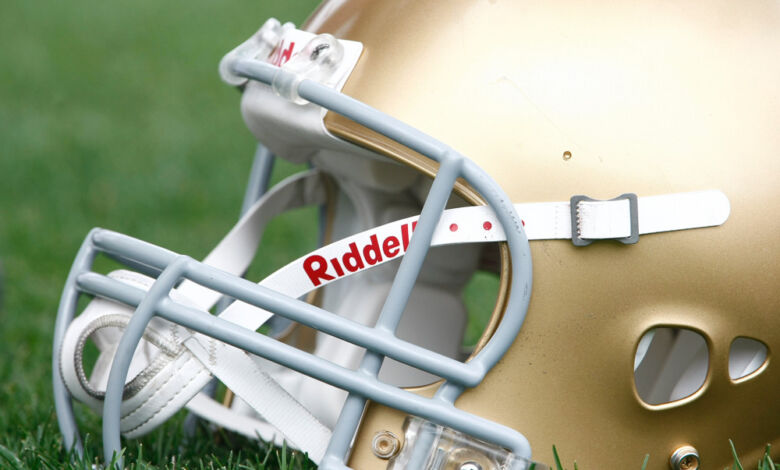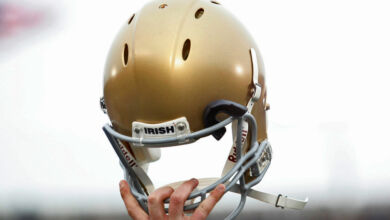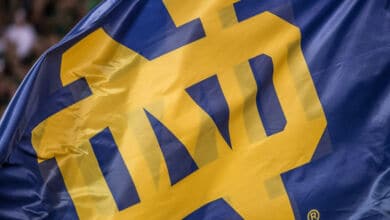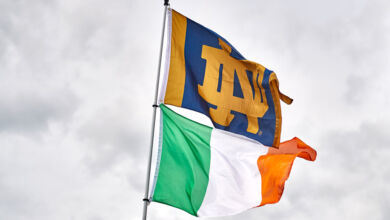
The last time the Notre Dame Fighting Irish lost to the Army Black Knights was in 1958. Since then, the Irish have run off 15 straight victories, many of them ending in a rout. During that lengthy run of success, the 28-27 nail-biting win in 1995 marks the closest that Notre Dame has come to defeat. With Notre Dame and Army set to square off this year for the first time since 2016, no one is hoping for a similar thriller at Yankee Stadium.
Army was technically the home team in this matchup that took place at the original Giants Stadium in the New Jersey Meadowlands. The Black Knights entered the game with a 1-2-1 record and were coming off a 21-21 tie to Rice. The 17th-ranked Irish were coming off a win at Washington but had dropped two of their six games thus far.
The Coaches: Lou Holtz coaching from the pressbox
Lou Holtz was in his 10th season heading the Notre Dame program, compiling an 87-26-2 record before this contest. He had one national championship to his credit but had managed only a 10-7 mark since the start of the 1994 campaign. For this clash, Holtz was forced to communicate from the press box after having recently undergone spinal surgery.
‘Bob Sutton was at the midway point of his nine seasons as Army’s head coach, taking a 20-27-1 record into the game. That nine-year tenure remains the second-longest in the program’s history, with only the legendary Earl Blaik ahead of him.
The Key Players: Powlus and loaded backfield pace Irish offense
Ron Powlus was in his second of four seasons as starting quarterback for the Irish, putting up similar numbers to his freshman campaign the year before. The running back trio of Randy Kinder, Marc Edwards and Autry Denson were on their way to collectively gaining over 2,200 yards and scoring 26 rushing touchdowns that season. Edwards was also a receiving option, with Derrick Mayes the main weapon Powlus had through the air.
Army, like the other service academies, relied heavily on the run. In the Black Knights’ case, that meant a Wishbone attack which had Ronnie McAda at quarterback. McAda did throw for over 700 yards that year, but his rushing output nearly matched that total. Topping the runners’ production was John Conroy, while the meager passing attack had only three players in double-digits for receptions, none higher than 15 catches that year.
The Game: Ivory Covington saves Notre Dame season with iconic play
Army’s first drive ended quickly, with Notre Dame taking advantage of great field position to start its first series at the Black Knight 42. Using a little over four minutes, the Irish moved eight plays and picked up three first downs along the way to help set up a two-yard scoring run by Denson.
Following a touchback on the ensuing kickoff, Army immediately gained 38 yards on its first two offensive calls. The Black Knights then chewed up some clock, moving the final 42 yards of the drive over 10 plays. As dominant as the ground game was for Army, it was a one-yard scoring toss from McAda to tight end Ron Leshinski, that knotted the score at seven.
Just like their opponents, the Irish answered back with a 70-yard drive that took less than two minutes to move the margin back to seven points at 14-7. Powlus found Mayes for 36 yards to provide the biggest spark of the drive, with Edwards eventually running it in from the two.
In the second quarter, Notre Dame exploited an Army fumble and doubled its lead on a drive that started at the Black Knight 20. Powlus and Mayes again hooked up, this time on the first play, to move it to the Army 32. Five plays later, another Denson two-yard scoring run sent the Irish to intermission with some breathing room.
That comfort level expanded even more when the Irish took the second-half kickoff and moved 74 yards on six plays to take a 28-7 lead. The scoring play was set up by some outstanding blocking and allowed Edwards to take Powlus’ screen pass for a 46-yard score.
The Irish were likely hoping that the Edwards’ score would end Army’s hopes of an upset but the Black Knights answered back with an 11-play, 60-yard drive that culminated with a five-yard run into the end zone by Conroy.
Notre Dame then began to subject itself to costly self-inflicted wounds that nearly proved fatal. Moving the ball down to the Army 6, Edwards fumbled the ball away and by the early part of the fourth quarter, the Black Knights had the ball at the Irish 10. However, the drive stalled and a fourth-down try failed.
Yet, Notre Dame again quickly gave the ball back when Powlus was intercepted at the Irish 33. Going back to the pass, McAda found Coby Short for 24 yards and Conroy soon pushed through again to make it 28-21 with slightly over four minutes left.
The Irish found themselves facing a fourth-and-inches situation at their own 40 with less than three minutes left. From the press box, Holtz was screaming to let the clock run down before calling a timeout. However, he discovered to his horror that his headphones weren’t working. Powlus’ subsequent call of a quarterback sneak backfired when he fumbled the ball away with 2:33 remaining.
Starting at the Notre Dame 42, Army managed to pick up a pair of first downs and reached the Irish seven. From there, McAda found Leon Gant, who scored with 39 seconds left. As three-touchdown underdogs, the Black Knights had little to lose by going for the win on a two-point conversion attempt. That decision helped set the stage for a dramatic moment in Irish football history.
McAda rolled out right and found the 240-pound Leshinski at the one. Instead of delivering an upset win, Leshinski was stopped by Notre Dame’s 165-pound cornerback, Ivory Covington, with the goal line roughly a foot away to clinch the hard-fought victory.
The Aftermath: Notre Dame cruised to Orange Bowl matchup with Florida State
The Irish’s inconsistent play was chalked up to the perception that they were looking ahead to their home rivalry matchup the following week against Southern Cal. Regardless, the scare woke Notre Dame up enough for the squad to win its final four regular season games. However, they ended up dropping a 31-26 decision in the Orange Bowl to the Florida State Seminoles, finishing 9-3 on the year.
That bowl trip would be the final one in the Holtz era, with his 8-3 record in 1996 bringing an end to his 11 seasons with the Irish. A late-season loss that year knocked Notre Dame from the bowl alliance, which led to the school declining to play in a lower-echelon bowl game. Bob Sutton was at the midway point of his nine seasons as Army’s head coach, taking a 20-27-1 record into the game. That nine-year tenure remains the second-longest in the program’s history, with only the legendary Earl Blaik ahead of him.



